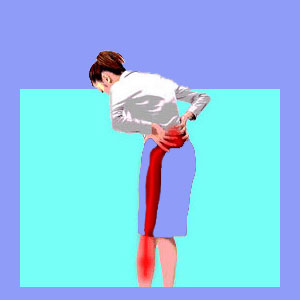
Women’s sciatica might not feel much different from the symptoms experienced by men, but in some cases, the source process may be very gender-specific. The causes of sciatica in women are more diverse than in the male gender, including several possibilities which do not exist in the male anatomy.
It is crucial, as a woman, to learn about the specific reasons why you might suffer female back pain, so that you can devise an effective treatment strategy with your physician. Always be sure to consider the female-specific causes of sciatica detailed in this article, along with the more traditional reasons why lower body nerve pain might exist.
Sources of Women’s Sciatica
Of course, all the normal sources of sciatica which affect men can also apply to women. This includes back injury, rare instances of advanced spinal degeneration and psychosomatic factors. These causations account for the overwhelming majority of sciatic nerve complaints in both men and women alike. However, there are some female gender-specific reasons which might also enact radicular pain in the lower back and legs of women only:
The menstrual cycle can cause lower back pain some months or regularly. Hormonal changes in the body can really take a toll on the anatomy and the emotional self, as well.
Pregnancy can cause back pain due to hormonal changes and actual structural nerve compression issues, typically related to the fetus pressing on a neurological structure, circulatory vessel or internal organ.
Postpartum sciatica pain can exist due to psychosomatic reasons or injury during birth. This injury might be as mild as muscular back strain from pushing during labor, or might be more severe, such as a fractured coccyx from the actual delivery.
Female Sciatica Answers
It is often wise to consult both a traditional back pain care provider, such as a chiropractor or an orthopedist, as well as an OB/GYN physician when experiencing back pain which you suspect might be related to a gender-specific issue. This is even better advice if you are pregnant or a new mother. Finding common ground between the 2 diagnoses will help you to better understand your pain and will reduce the likelihood of being misdiagnosed.
Keep in mind that lifestyle factors and genetics also play crucial roles in who might suffer from any type of chronic pain. While these types of syndromes may have both anatomical and psychological contributory processes which are responsible for the pain, other less easily documented factors should be considered, such as smoking, regular alcohol usage, general fitness level and a past history of involvement in certain high risk activities, such as gymnastics, horseback riding or martial arts.
Remember that many orthopedic or neurological physicians might not take into account the gender-specific reasons for pain, so be sure to bring these up during consultation. Always talk to a women’s health professional for best symptomatic correlation results.
Women’s Sciatica Advice
Remember, as women, you must consider all the potential sources of your pain, in order to realize a complete symptomatic profile and achieve an accurate diagnosis. Once you can positively identify the reasons why you hurt, finding lasting relief will be much easier. If you miss a crucial factor along the way, your pain will endure, making life hellish and creating an added burden on your already busy life.
Talk to all your care providers about your pain, before making up your mind on a sciatica treatment plan. Always consult your OB/GYN if your pain is related to pregnancy, birth, birth control or the menstrual cycle, since these factors might be overshadowed by other diagnostic theories embraced by general back pain specialists.




